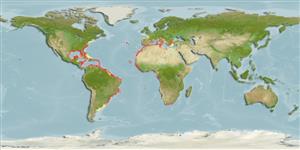>
Eupercaria/misc (Various families in series Eupercaria) >
Labridae (Wrasses) > Xyrichtyinae
Etymology: Xyrichtys: Greek, xyreo = that cuts like a knife + Greek, ichthys = fish (Ref. 45335); novacula: Specific name from Latin 'novacula' meaning 'razor'; referring to it being very compressed with front of head forming a sharp edge.
More on author: Linnaeus.
Environment: milieu / Klimaatzone / Diepte / distribution range
Ecologie
marien rifbewoner; diepte 1 - 90 m (Ref. 3726). Subtropical
Western Atlantic: North Carolina, USA and northern Gulf of Mexico (Ref. 7251) through the Caribbean to Brazil. Eastern Atlantic: France to Angola and including the Mediterranean, Azores, Madeira, Canary Islands, Cape Verde and Sao Tome Island.
Grootte / Gewicht / Leeftijd
Maturiteit: Lm ? range ? - ? cm
Max length : 38.0 cm TL mannelijk / geslacht onbekend; (Ref. 7251); common length : 20.0 cm TL mannelijk / geslacht onbekend; (Ref. 2683); max. gerapporteerde leeftijd: 8 Jaren (Ref. 4742)
Dorsale stekels (totaal) : 9; Dorsale zachte stralen (totaal) : 12; Anale stekels: 3; Anale zachte stralen: 12. An elongate, very compressed fish with front of head forming a sharp edge. Snout very blunt; profile steep. Pale greenish, usually with no conspicuous markings on body (Ref. 26938). Head with alternating vertical lines of light blue and light yellow-orange (Ref. 13442).
Body shape (shape guide): elongated.
Inhabits clear shallow areas with sandy bottoms, usually in the vicinity of seagrass beds and corals (Ref. 2683). Feeds mainly on mollusks; also crabs and shrimps (Ref. 3726). A protogynous hermaphrodite; sexual dimorphism apparent in head shape and length of pelvic fin (Ref. 5292). Builds nests with coral debris. Dives head first into the sand when frightened (Ref. 9710). Marketed fresh (Ref. 3726).
Levenscyclus en paargedrag
Maturiteit | Voortplanting | Paaien | Eieren | Fecunditeit | Larven
Gomon, M.F. and P. Forsyth, 1990. Labridae. p. 868-882. In J.C. Quero, J.C. Hureau, C. Karrer, A. Post and L. Saldanha (eds.) Check-list of the fishes of the eastern tropical Atlantic (CLOFETA). JNICT, Lisbon, SEI, Paris; and UNESCO, Paris. Vol. 2. (Ref. 5292)
Status op de Rode Lijst van het IUCN (Ref. 130435: Version 2024-2)
Gevaar voor de mens
Harmless
Gebruik door de mens
Visserij: van minder commercieel belang; sportvis: ja; Aquarium: Commercieel
Tools
Speciale rapporten
Download XML
Internetbronnen
Estimates based on models
Preferred temperature (Ref.
123201): 17.4 - 27.9, mean 24.4 °C (based on 858 cells).
Fylogenetische diversiteitsindex (Ref.
82804): PD
50 = 0.5005 [Uniqueness, from 0.5 = low to 2.0 = high].
Bayesian length-weight: a=0.00955 (0.00676 - 0.01349), b=3.00 (2.90 - 3.10), in cm total length, based on LWR estimates for this species (Ref.
93245).
Trofisch niveau (Ref.
69278): 3.5 ±0.1 se; based on diet studies.
Generation time: 4.2 ( na - na) years. Estimated as median ln(3)/K based on 2
growth studies.
Weerstandsvermogen (Ref.
120179): Gemiddeld, minimale populatieverdubbelingstijd 1,4-4,4 jaar (tmax=8).
Fishing Vulnerability (Ref.
59153): Moderate vulnerability (36 of 100).
🛈
Nutrients (Ref.
124155): Calcium = 32.8 [14.9, 67.1] mg/100g; Iron = 0.522 [0.286, 1.082] mg/100g; Protein = 18.8 [15.9, 21.0] %; Omega3 = 0.142 [0.077, 0.259] g/100g; Selenium = 18.7 [8.5, 39.1] μg/100g; VitaminA = 56.4 [15.9, 255.3] μg/100g; Zinc = 0.892 [0.550, 1.509] mg/100g (wet weight);
